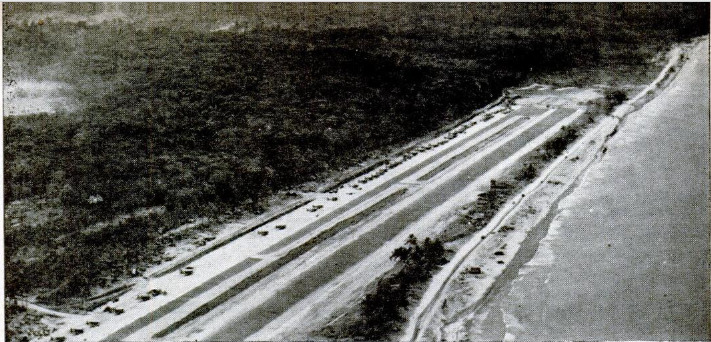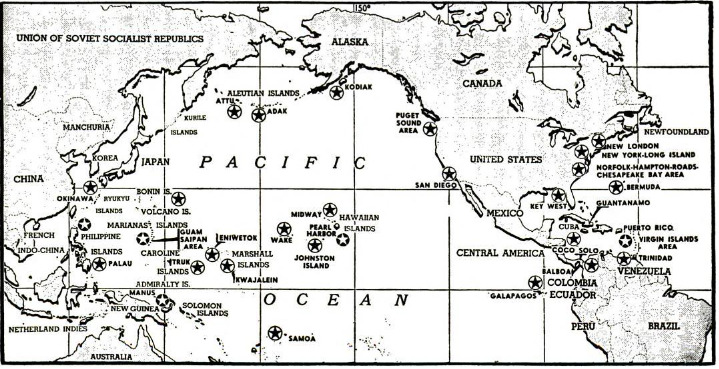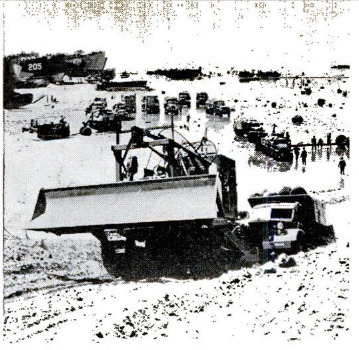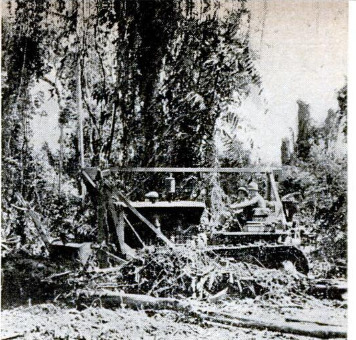-
Title (Dublin Core)
-
Navy's island empire
-
Article Title and/or Image Caption (Dublin Core)
-
Title: Navy's island empire
-
extracted text (Extract Text)
-
GREAT, roaring construction machines
continue to carve out the United
States Navy's permanent, peacetime ad-
vance base needs in both the Atlantic and
Pacific oceans. Peace, which ended the
shooting, only intensified the base-hungry
Navy's efforts to secure its strategic stran-
glehold on Japan, its shock-absorbing sea
and air anchorages against aggression.
Fifteen major bases, nine of them in the
Pacific (see map on this page), were pro-
posed as necessary by the Navy in its re-
quest for funds to make them assaultproof
and equip them for their strategic purpose.
Fleet bases have four primary functions.
They must be used for supplying the fleet;
furnishing air support; and repairing and
maintaining forces afloat and in the air.
Also, they must be equipped sufficiently for
use as staging areas for personnel and sup-
plies for attack purposes. All of these func-
tions require construction on a vast scale,
construction that is roaring ahead at the
present time on a day-and-night basiz, with
Seabees and Army Engineers tumbling york
records on every shift.
Bases, besides the dock and harbor fa-
cilities and the vast airstrips, must contain
homes for thousands, power, fuel, food, and
recreation operations on a scale dwarfing
some of the nation’s industrial cities. On
Guam, for example, 113 acres of covered
storage, hospitals with a bed capacity of
9,550, seven main and 125 branch telephone
exchanges, a water system of 15,000,000
gallons per day, and 113 miles of paved
roads have been constructed since the island
was retaken. On Tinian, 39 miles of run-
ways have been built; asphalt surfacing, on
airfields alone, would pave a highway from
Washington, D. C., to Boston. On Saipan,
enough cable for power and communications
has been laid to reach from New York to
San Francisco 335 times.
In the Philippines, where nature is the
greatest obstacle construction men must
overcome, 12 naval installations are nearing
completion. Seabees, during the early days
of the invasion, stood helpless while heavy
equipment sank out of sight in the mud
when removed from landing craft.
Starting with the bases available to the
United States Navy on December 7, 1941, a
total of 434 have been used during the war
in both the Atlantic and Pacific. On June
30, 1945, the Navy estimated that the cost
of construction, excluding the cost of labor
or technical materials, was over two billion
dollars. Cost of the vast expansion ahead
has not been officially estimated by the
Navy, but generally is considered to be in
the neighborhood of another two billion.
-
Language (Dublin Core)
-
Eng
-
Date Issued (Dublin Core)
-
1945-11
-
pages (Bibliographic Ontology)
-
90-91
-
Rights (Dublin Core)
-
Public domain
-
Archived by (Dublin Core)
-
Sami Akbiyik
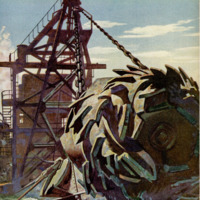 Popular Science Monthly, v. 147, n. 5, 1945
Popular Science Monthly, v. 147, n. 5, 1945

